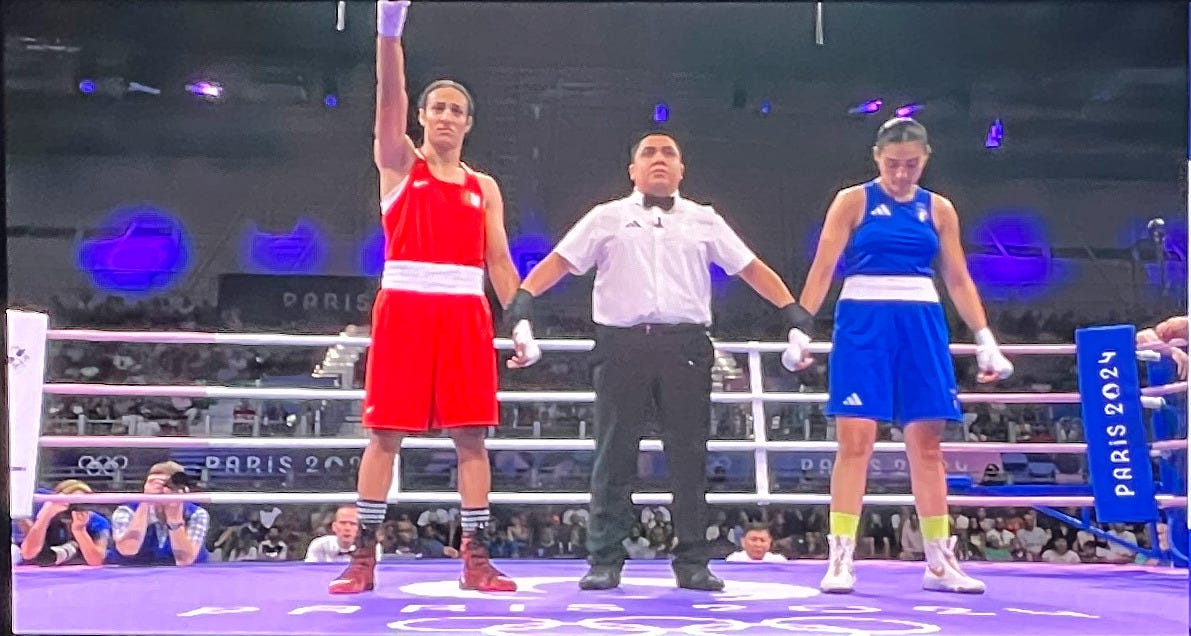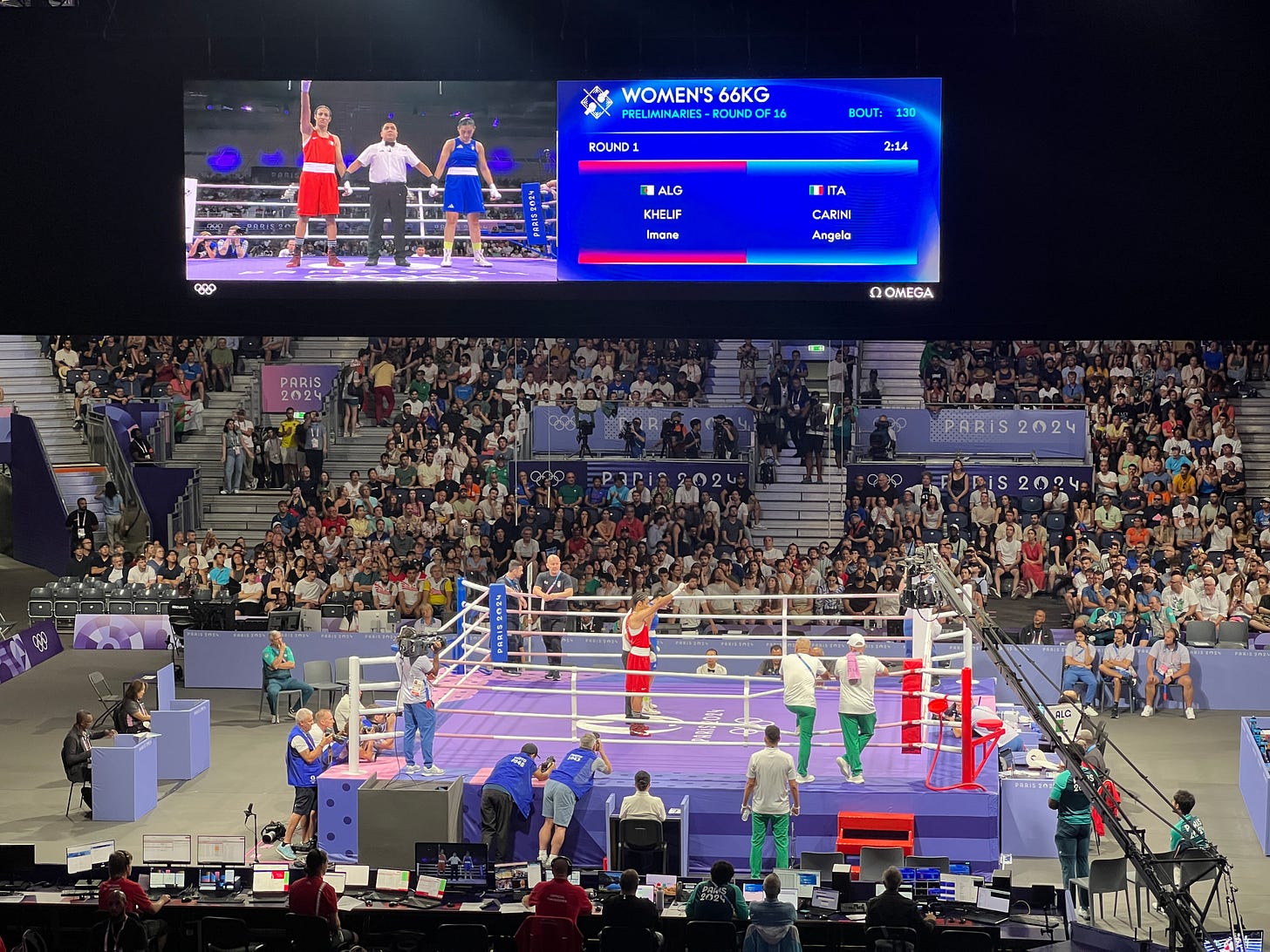We have been talking for the last few weeks about pronouns, and gender more broadly. I mentioned a few weeks ago that gender is ultimately a social construct, and has historically been viewed as a spectrum (outside of the last 200 years or so) rather than a strict binary. The problem with a strict gender binary is, where do you put the line? What quality or characteristic defines who is male or female? One of the most obvious dividing lines is, of course, the physiology present at birth.

Enter the international controversy this last week of the Olympic Women’s Boxing match between the Algerian contender, Imane Khelif, and the Italian contender, Angela Carini. The match ended after only 46 seconds when Carini abandoned the bout, noting that she had been hit particularly hard by Khelif. The media then immediately speculated about Khelif’s gender because she has what some think are more masculine features. The controversy also reopened ongoing debate about Khelif’s gender eligibility test last year at the world championship where Khalif was disqualified because her testosterone level was higher than their threshold Several notable figures added to the call for Khalif’s disqualification from the Olympics including Italian Premier Giorgia Meloni, former U.S. President Donald Trump, and author (and anti-trans activist) J.K. Rawling.
The problem with the physiology argument: Imane Khalif was assigned female at birth; she is and always has been physiologically female. She has lived her entire life identifying as a female. She thinks of herself as female. Perhaps most notably, she also is representing the country of Algeria, one in which gender-affirming care is strictly illegal. If she were actually a man contending as a woman (as her critics contend) there is no way that she would be allowed to represent her country. Since this is the case, her critics seem to be in the place of arguing that gender and sex are actually two different things, and that gender is not necessarily tied to physiology.
Imane Khalif was assigned female at birth; she is and always has been physiologically female. She has lived her entire life identifying as a female. She thinks of herself as female. Perhaps most notably, she also is representing the country of Algeria, one in which gender-affirming care is strictly illegal.
Both Khalif and the Taiwanian boxer, Lin Yu-ting were disqualified from the 2023 world championships because their testosterone levels were higher than the benchmark set by the International Boxing Association. However, neither were disqualified from competing in the Olympics, because last year the International Olympic Committee voted to de-recognize the IBA, and oversee regulations themselves because of the IBA’s lack of integrity. Both have since won metals this Olympics. [While the IOC briefly tested for testosterone in women whose gender was in question, it has not done so since changing their policy in 2015 back to those recommended by World Athletics. While men tend to produce more testosterone than women, and women tend to produce more estrogen than men, hormone levels fluctuate from person to person, over a person’s life, and even from day to day. Because testosterone helps with muscle development and physical performance, it is not surprising that professional athletes (both male and female) tend to have higher testosterone levels than their counterparts in the general populace.] Again, the issue for a strictly binary view of sex and gender is this: at what point do you divide the two? Do you say that anyone above a 10 nmol/L range in testosterone is male, and anyone below is female, regardless of physiology? This would be like saying anyone over 5’8” is a man.

A brief aside on chromosomes. There were some early rumors that Khalif’ has an X and Y chromosome (like most men). This does not seem to be the case, but chromosomal tests have the same issues as hormonal ones. Most women have XX chromosomes, and most men have XY chromosomes. However, there are notable Differences in Sexual Development in which development of genitalia and chromosomal arrangement do not follow the typical pattern, or where alternate chromosomal configurations are present (XO or XXY).
One of the things that has been most touching to me has been seeing the response from other women who happen to appear masculine, like the American Rugby star (and social media legend), Ilona Maher. These women have been sharing their struggles with constantly being misgendered, screamed at in women’s bathrooms, and otherwise being harassed because they ‘look like a man.’ The emotional toll (and trauma) that we place on young women to conform to a certain set of standards is bad enough without piling on. Imane Khalif herself recently called for the end to bullying athletes which “harms human dignity.”
At the end of the day, a strictly binary view of gender does not actually work for the beautiful diversity that we see around us, and that we as Christians believe has been created by God.
At the end of the day, a strictly binary view of gender does not actually work for the beautiful diversity that we see around us, and that we as Christians believe has been created by God. There are some women who are more feminine than others and some more masculine than others, the same goes for men and non-binary persons. One of the wonderful things about the Olympics is the opportunity to see the very peak of human possibility. I am certain that any woman competing as an Olympic boxer could whip my butt, regardless of her testosterone level. Perhaps we can just love and accept one another as fellow complex human beings, who know more about their own gender than we do. You know, love our neighbor as ourselves.




